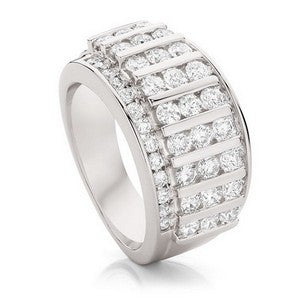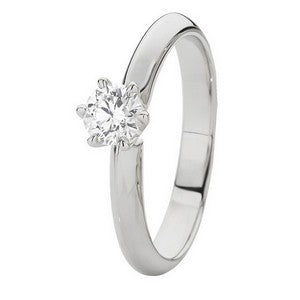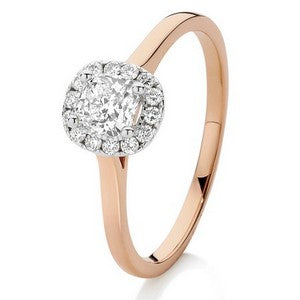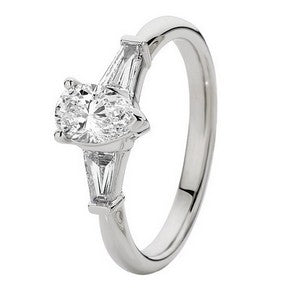Engagement Ring Style Guide
Everything You Need To Know About Engagement Rings
We strongly encourage men (and women) to discover what it is their partner likes by way of diamond shape, size, setting and metal colour preference.
It can be very daunting walking into a jewellery store knowing you are faced with so many decisions and let’s face it, it’s probably one of the biggest purchases you will make so you should equip yourself with as much information as possible. You will soon discover that because there are so many attributes and qualities that a diamond possesses you are unlikely to always be comparing “apples with apples”.
Alternatively, if you’re like a growing number of couples, you may find yourselves making the decision jointly. When making the decision, make sure that you keep the following in mind.
Diamond Settings
There are numerous ways in which a diamond can be set. You will find some of the most popular settings below.

Claw Settings
Claw settings are one of the most common settings used for engagement rings. There are usually four or more metal bars, which secure the diamond in place and allow light to enter the diamond from all angles.
A claw setting can be tall, positioning the diamond well above the band or it can be short, meaning the diamond is positioned closer to the finger.
Care must be taken with claw settings as they are prone to snagging and over time the claws may loosen exposing the diamond. Ask your Showcase Jeweller to make regular inspections.

Bezel Setting
A bezel setting is a frame that wraps around the diamond offering the diamond greater protection.
One of the disadvantages of a bezel setting is the lack of light that is permitted through which may result in the diamond looking smaller.
To overcome this problem a half-bezel setting can be created which still offers the security and allows light to the diamond.

Channel Setting
Channel settings are quite common on engagement ring shoulders as well as wedding bands. A metal channel holds the diamonds securely together with the diamonds appearing in an elegant row.
Brilliant cut diamonds are most common in these types of settings as they offer great sparkle however baguettes or squares can also be used to offer a nice contrast to the main diamond.

Pavé Setting
o produce a pavé setting, small holes are drilled into the shank of the ring that allows tiny diamonds to be placed into it. In order to hold the diamonds securely, small beads of metal are placed in the setting. The diamonds should reduce in size in areas where the pavé area narrows.

Bar Setting
A bar setting is similar to a channel setting except that the metal plates rise to the top of the diamond and are visible between the diamonds.

Other settings
If you are unsure on the type of setting you desire then speak to your local Showcase Jeweller. They will be able to offer your sound advice based on your preferences and lifestyle.
- Cluster settings where multiple stones are grouped together to give the appearance of a larger stone or to create abstract designs.
- Flush settings which set the diamonds into the ring in such a way they sit flush with the surface.
- Tension settings which hold the diamonds in place with minimum visible support but maximum protection.
Precious Metals
Another consideration is the type of metal you will use in your engagement ring and wedding bands. Gold in either yellow or white is very popular, although rose gold is becoming increasingly common. 18ct gold is the most common used metal as it retains its rich colour and contains fewer alloys that can sometimes provoke allergies in some people. Gold does scratch easy and will be subject to wear and tear over the years.
An alternative metal is platinum, which is a much rarer metal to acquire and is almost twice the weight of gold. It is one of the purest and finest metals available and is naturally white in colour.
Platinum, unlike gold, will not blemish or scratch easily and can be easily brought back to life with light soaking and buffing. Gold on the other hand needs to be re polished in order for it to return to its original lustre.
Most of the engagement rings shown on this site are 18ct gold however if you would like prices on different metals then simply visit your nearest Showcase Jeweller for a free consultation.
Engagement Ring Style

Halo
The halo style is becoming increasingly popular. It is for people who love solitaires but ache for something a little more glamorous. This can be experimented with by using two-tone gold or different coloured stones.

The Double Halo
The double halo is a statement piece. It is for the bold and confident woman. They work well with two-tone gold and with different coloured stones.

Split Bands
Split bands add modern design to a simple solitaire. The twists in the metal symbolise the coming together of two people.

Solitaire
A single diamond set in your choice of metal and preferred setting. It is a classic and timeless look. It matches any outfit and exudes under stated elegance.

Shoulders
The band features smaller diamonds, typically rounds or squares and can extend all the way around the band or half way.

Trilogy
Typically features one larger centre stone with two smaller stones on either side. The stones are symbolic of your love in the past, present and future.

Two-Toned
Most two-tone designs are in a combination of yellow and white gold, however white gold and rose gold is becoming increasingly popular. Rose gold is ideal to highlight pink diamonds or just to add some contrast whereas white gold is used for the claws or prongs to help keep the diamond looking as white and bright as possible.

Multiple Stones
Multiple stone shape rings take cues from the vintage era, they never go out of fashion and always hold a great demand. This is a ring for the risk taker who wants something unique and quirky.

Cluster
This is a statement piece and is for women who love something different. With clusters many different shapes can be made, such as flowers and stars. They are most commonly featured on single bands with no shoulders, in order to make the shape the focal point of the piece.
